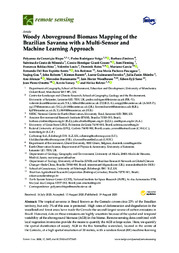Woody Aboveground Biomass Mapping of the Brazilian Savanna with a Multi-Sensor and Machine Learning Approach.
Woody Aboveground Biomass Mapping of the Brazilian Savanna with a Multi-Sensor and Machine Learning Approach.
Author(s): BISPO, P. da C.; RODRÍGUEZ-VEIGA, P.; ZIMBRES, B.; MIRANDA, S. do C. de; CEZARE, C. H. G.; FLEMING, S.; BALDACCHINO, F.; LOUIS, V.; RAINS, D.; GARCIA, M.; ESPIRITO-SANTO, F. D. B.; ROITMAN, I.; PACHECO-PASCAGAZA, A. M.; GOU, Y.; ROBERTS, J.; BARRETT, K.; FERREIRA, L. G.; SHIMBO, J. Z.; ALENCAR, A.; BUSTAMANTE, M.; WOODHOUSE, I. H.; SANO, E. E.; OMETTO, J. P.; TANSEY, K.; BALZTER, H.
Summary: The tropical savanna in Brazil known as the Cerrado covers circa 23% of the Brazilian territory, but only 3% of this area is protected. High rates of deforestation and degradation in the woodland and forest areas have made the Cerrado the second-largest source of carbon emissions in Brazil. However, data on these emissions are highly uncertain because of the spatial and temporal variability of the aboveground biomass (AGB) in this biome. Remote-sensing data combined with local vegetation inventories provide the means to quantify the AGB at large scales. Here, we quantify the spatial distribution of woody AGB in the Rio Vermelho watershed, located in the centre of the Cerrado, at a high spatial resolution of 30 metres, with a random forest (RF) machine-learning approach. We produced the first high-resolution map of the AGB for a region in the Brazilian Cerrado using a combination of vegetation inventory plots, airborne light detection and ranging (LiDAR) data, and multispectral and radar satellite images (Landsat 8 and ALOS-2/PALSAR-2). A combination of random forest (RF) models and jackknife analyses enabled us to select the best remote-sensing variables to quantify the AGB on a large scale. Overall, the relationship between the ground data from vegetation inventories and remote-sensing variables was strong (R2 = 0.89), with a root-mean-square error (RMSE) of 7.58 Mg ha−1 and a bias of 0.43 Mg ha−1. View Full-Text
Publication year: 2020
Types of publication: Journal article
Unit: Embrapa Cerrados
Keywords: Biomassa, Carbono, Cerrado, Sensoriamento Remoto
Observation
Some of Embrapa's publications are published as ePub files. To read them, use or download one of the following free software options to your computer or mobile device. Android: Google Play Books; IOS: iBooks; Windows and Linux: Calibre.
Access other publications
Access the Agricultural Research Database (BDPA) to consult Embrapa's full library collection and records.
Visit Embrapa Bookstore to purchase books and other publications sold by Embrapa.

